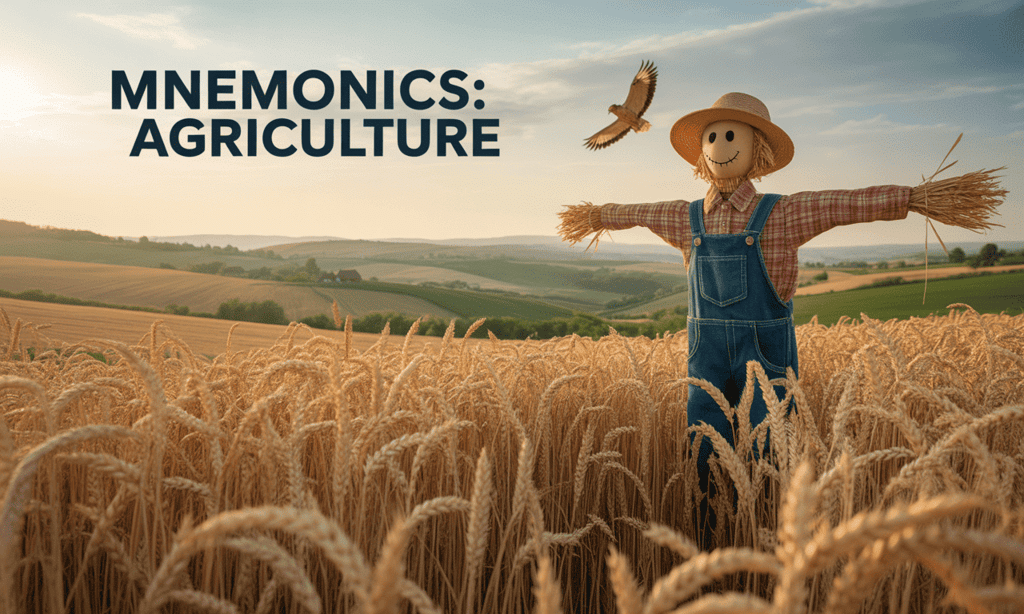Class 10 Exam > Class 10 Notes > Social Studies (SST) Class 10 > Mnemonics: Agriculture
Mnemonics: Agriculture | Social Studies (SST) Class 10 PDF Download

1. Types of Farming
Mnemonic: "PIC" your farming method
- P – Primitive Subsistence Farming
- I – Intensive Subsistence Farming
- C – Commercial Farming
2. Primitive Subsistence Farming – Regional Names
Mnemonic: "Jungle People Bake Delicious Pies Just Very Kindly"
- J – Jhumming (NE states like Assam, Meghalaya)
- P – Pamlou (Manipur)
- B – Bewar/Dahiya (Madhya Pradesh)
- D – Dipa (Chhattisgarh)
- P – Podu/Penda (Andhra Pradesh)
- J – Jhumming (again, NE)
- V – Valre/Waltre (SE Rajasthan)
- K – Khil/Kuruwa (Himalayan belt, Jharkhand)
3. Intensive Subsistence Farming – Pressure on Land
Mnemonic: "DIVIDE land, MAX output, FEEL pressure"
- D – Division of land due to inheritance
- M – Maximize output from small holdings
- P – Pressure on land increases
4. Commercial Farming Characteristics
Mnemonic: "High Input Crops Pay Tremendously"
- H – HYV seeds
- I – Insecticides & fertilizers
- C – Commercial in some regions
- P – Plantation farming (tea, coffee)
- T – Transport essential for plantation success
5. Cropping Seasons
Mnemonic: "Real Kings Zap"
- R – Rabi (Winter sowing, Summer harvesting: Wheat, Barley, Mustard)
- K – Kharif (Monsoon sowing: Paddy, Maize, Bajra)
- Z – Zaid (Summer between Rabi & Kharif: Watermelon, Cucumber)
6. Major Crops – Grains
Mnemonic: "Really Wise Men Prefer Sweet Corn"
- R – Rice
- W – Wheat
- M – Millets (Jowar, Bajra, Ragi)
- P – Pulses
- S – Sugarcane
- C – Corn (Maize)
7. Oilseeds
Mnemonic: "Some Great Men Cook Soy Candles Lightly"
- S – Sesame
- G – Groundnut
- M – Mustard
- C – Coconut
- S – Soybean
- C – Castor
- L – Linseed
8. Maize – Ideal Conditions
Mnemonic: "M-A-I-Z-E"
- M – Monsoon crop (Kharif)
- A – Alluvial soil preferred
- I – Inputs (HYV seeds, fertilizers)
- Z – Zea mays (scientific name)
- E – Eaten and used as fodder
The document Mnemonics: Agriculture | Social Studies (SST) Class 10 is a part of the Class 10 Course Social Studies (SST) Class 10.
All you need of Class 10 at this link: Class 10
|
88 videos|630 docs|79 tests
|
FAQs on Mnemonics: Agriculture - Social Studies (SST) Class 10
| 1. What are the main types of agriculture practiced worldwide? |  |
Ans. The main types of agriculture include subsistence agriculture, where farmers grow food primarily for their own consumption; commercial agriculture, which is aimed at producing crops and livestock for sale; and mixed farming, which combines both crop cultivation and livestock rearing. Other types include organic farming, which avoids synthetic chemicals, and intensive farming, which maximizes yields through high inputs of labor and capital.
| 2. How does climate affect agricultural practices? |  |
Ans. Climate significantly influences agricultural practices by determining the types of crops that can be grown in a region. Factors such as temperature, rainfall, and seasonal changes dictate planting and harvesting times. For example, tropical regions with high rainfall support crops like rice and cassava, while arid climates favor drought-resistant crops like millet and sorghum.
| 3. What role do soil types play in agriculture? |  |
Ans. Soil types are crucial in agriculture as they affect water retention, nutrient availability, and crop growth. Different soils have varying textures and compositions, such as sandy, clayey, or loamy soils. Loamy soil is often considered the best for agriculture due to its balanced texture, which supports good drainage and nutrient retention, essential for healthy plant growth.
| 4. What are the environmental impacts of modern agriculture? |  |
Ans. Modern agriculture can lead to several environmental impacts, including soil degradation, loss of biodiversity, and water pollution from runoff of fertilizers and pesticides. Additionally, intensive farming practices contribute to greenhouse gas emissions and climate change. Sustainable practices, such as crop rotation and organic farming, are being promoted to mitigate these effects.
| 5. What is the significance of crop rotation in agriculture? |  |
Ans. Crop rotation is significant in agriculture as it helps maintain soil fertility, reduces pest and disease cycles, and promotes biodiversity. By alternating different crops in a specific sequence, farmers can improve soil structure and nutrient content, leading to better yields over time. This practice also minimizes the reliance on chemical fertilizers and pesticides.
Related Searches





















